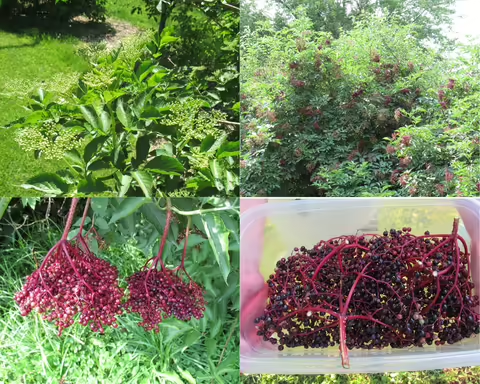We are officially into the dog days of summer; with daylight noticeably shorter than around the June solstice, berry season is sadly coming to an end. However, there is one local berry that is putting on a show right now. Besides its fruit, elderberry has many other contributions to the landscape that we can be thankful for. If you’re reading this in September, you’ve missed the berries, but read on so you can be on the lookout for edible perks of the elderberry next year!
At the Refuge Food Forest, elderberry is one of several woody, perennial crops that sequesters carbon, provides shelter for birds, and also provides an amazing abundance of nectar for pollinators in the spring. Next year around late May, head over to the Refuge Food Forest in Normal to see a stunning array of honeybees, bumblebees, ground bees, beetles, birds, flies and more which will be covering the umbel-shaped white flower clusters of the elderberry. These are impossible to miss; do yourself a favor next spring and go admire the flowers. While you’re at it, smell them!
Speaking of elderflowers, Europeans – who brought the European elderberry over to the U.S. – make elderflower teas, liqueurs and candies out of a few elderflower clusters each year. Wow, they must be good!
The elderberry is somewhat steeped in folk mystery… some people will not use this plant because they think it’s somewhat poisonous. It turns out that they are right! The leaves, roots, stems, and any other part of the plant besides the flowers and fruits are mildly poisonous. To boot, the elderberries themselves should NOT be consumed raw; they have compounds in them that can make you sick, uncooked. However, if the berries are separated from the umbel (the weird-shaped berry stem that holds the fruits) and cooked down for a period of time in a little water, honey and spices, one can make a nutritious elderberry syrup!
Elderberry has 10 grams of fiber per 100 calories of fruit, making it one of the best supplies of fiber in the world of fruit! It’s also extremely high in beneficial antioxidants. In the past, this syrup has been prized for its use in alleviating symptoms of the common cold. The science is still out on this claim but do your own research; there are other uses for this syrup too. On pancakes? Ice cream? Sounds good!
Let’s say for the sake of argument that the reader of this newsletter is not interested in rolling the dice with elderflower or berry ingestion. Consider this though: the elderberry can grow to a height of 10-20’ tall, and turns bushy, expanding out new shoots from the base annually. This makes it an excellent landscaping plant to use as a privacy screen, if planting along your fencerows or property lines. Within two or three years, you’ll have a wall of elderberry bushes if planted every 6’ or so.
And who doesn’t want an edible, pollinator-friendly fence line?
ABOUT THE AUTHOR: Nick Frillman is a Local Foods and Small Farms Educator serving Livingston, McLean & Woodford counties. A fourth-generation graduate from University of Illinois, Frillman has a B.A. with a double major of Political Science and Spanish and a M.S. in Crop Science with a focus on crop production. Before joining Illinois Extension, Frillman completed a field season of CSA and farmers’ market style production at a small “beyond-organic” vegetable farm in Sandy, Ore.
